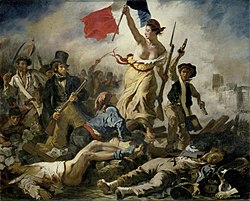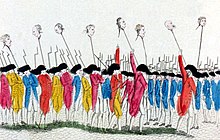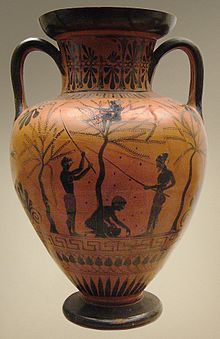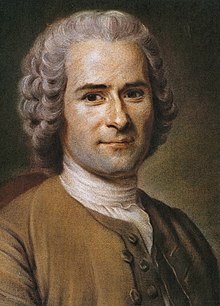The most successful slave rebellion in history was the 18th-century Haitian Revolution, led by Toussaint Louverture and later Jean-Jacques Dessalines who won the war against their French colonial rulers, which established the modern independent state of Haiti from the former French colony of Saint-Domingue. Another famous historic slave rebellion was led by the Roman slave Spartacus (c. 73–71 BC). In the ninth century, the poet-prophet Ali bin Muhammad led imported East African slaves in Iraq during the Zanj Rebellion against the Abbasid Caliphate; Nanny of the Maroons was an 18th-century leader who rebelled against the British in Jamaica; and the Quilombo dos Palmares of Brazil flourished under Ganazumba (Ganga Zumba). The 1811 German Coast Uprising in the Territory of Orleans was the largest rebellion in the continental United States; Denmark Vesey rebelled in South Carolina, and Madison Washington during the Creole case in the 19th century the United States.
Ancient Sparta had a special type of serf called helots who were often treated harshly, leading them to rebel. According to Herodotus (IX, 28–29), helots were seven times as numerous as Spartans. Every autumn, according to Plutarch (Life of Lycurgus, 28, 3–7), the Spartan ephors would pro forma declare war on the helot population so that any Spartan citizen could kill a helot without fear of blood or guilt in order to keep them in line (crypteia).
In the Roman Empire, though the heterogeneous nature of the slave population worked against a strong sense of solidarity, slave revolts did occur and were severely punished. The most famous slave rebellion in Europe was led by Spartacus in Roman Italy, the Third Servile War. This war resulted in the 6000 surviving rebel slaves being crucified along the main roads leading into Rome. This was the third in a series of unrelated Servile Wars fought by slaves against the Romans.
The English peasants' revolt of 1381 led to calls for the reform of feudalism in England and an increase in rights for serfs. The Peasants' Revolt was one of several popular revolts in late medieval Europe. Richard II agreed to reforms including fair rents and the abolition of serfdom. Following the collapse of the revolt, the king's concessions were quickly revoked, but the rebellion is significant because it marked the beginning of the end of serfdom in medieval England.
In Russia, the slaves were usually classified as kholops. A kholop's master had unlimited power over his life. Slavery remained a major institution in Russia until 1723, when Peter the Great converted the household slaves into house serfs. Russian agricultural slaves were formally converted into serfs earlier in 1679. During the 16th and 17th centuries, runaway serfs and kholops known as Cossacks, ("outlaws") formed autonomous communities in the southern steppes. There were numerous rebellions against slavery and serfdom, most often in conjunction with Cossack uprisings, such as the uprisings of Ivan Bolotnikov (1606–1607), Stenka Razin (1667–1671), Kondraty Bulavin (1707–1709), and Yemelyan Pugachev (1773–1775), often involving hundreds of thousands and sometimes millions. Between the end of the Pugachev rebellion and the beginning of the 19th century, there were hundreds of outbreaks across Russia.
Numerous African slave rebellions and insurrections took place in North America during the 17th, 18th, and 19th centuries. There is documented evidence of more than 250 uprisings or attempted uprisings involving 10 or more slaves. Three of the best known in the United States during the 19th century are the revolts by Gabriel Prosser in the Richmond, Virginia area in 1800, Denmark Vesey in Charleston, South Carolina, in 1822, and Nat Turner in Southampton County, Virginia, in 1831. Slave resistance in the antebellum South did not gain the attention of academic historians until the 1940s, when historian Herbert Aptheker started publishing the first serious scholarly work on the subject. Aptheker stressed how rebellions were rooted in the exploitative conditions of the southern slave system. He traversed libraries and archives throughout the South, managing to uncover roughly 250 similar instances.
Middle East
The Zanj Rebellion was the culmination of a series of small revolts. It took place near the city of Basra, in southern Iraq over fifteen years (869−883 AD). It grew to involve over 500,000 slaves, who were imported from across the Muslim empire.
Europe and the Mediterranean
In the 3rd century BCE, Drimakos (or Drimachus) led a slave revolt on the slave entrepot of Chios, took to the hills and directed a band of runaways in operations against their ex-masters.
The Servile Wars (135 to 71 BCE) were a series of slave revolts within the Roman Republic.
- The First and Second Servile War occurred in Sicily.
- The Third Servile War (73 to 71 BCE) occurred in mainland Italy. Spartacus, an escaped gladiator supposedly from Thrace, became the most prominent of the rebel leaders; Marcus Licinius Crassus suppressed the insurgents. Many modern rebels (such as the Spartacus League have since regarded Spartacus as a heroic figure.
Other slave revolts occurred elsewhere.
- Eumenes III, king of Pergamon from 133 to 129 BCE, promised freedom to slaves to draw support against the Roman Republic.
A number of slave revolts occurred in the Mediterranean area during the early modern period:
- 1748: Hungarian, Georgian and Maltese slaves on board the Ottoman ship Lupa revolted and sailed the ship to Malta.
- 1749: Conspiracy of the Slaves – Muslim slaves in Malta planned to rebel and take over the island, but plans leaked out beforehand and the would-be rebels were arrested and many were executed.
- 1760: Christian slaves on board the Ottoman ship Corona Ottomana revolted and sailed the ship to Malta.
São Tomé and Príncipe
On 9 July 1595, Rei Amador, and his people, the Angolars, allied with other enslaved Africans of its plantations, marched into the interior woods and battled against the Portuguese. It is said that day, Rei Amador and his followers raised a flag in front of the settlers and proclaimed Rei Amador as king of São Tomé and Príncipe, making himself as "Rei Amador, liberator of all the black people".
Between 1595 and 1596, the island of São Tomé was ruled by the Angolars, under the command of Rei Amador. On 4 January 1596, he was captured, sent to prison and was later executed by the Portuguese. Still today, they remember him fondly and consider him a national hero of the islands.
In the first decades of the 17th century, there were frequent slave revolts in the Portuguese colony of São Tomé and Príncipe, off the African shore, which damaged the sugar crop cultivation there.
South America and the Caribbean
December 25, 1522 rebellion in Diego Colón de Toledo's plantation in what is known today as Santo Domingo is the first known slave rebellion of the region.
Quilombo dos Palmares in Brazil, 1605 to 1694, led by Zumbi dos Palmarés.
San Basilio de Palenque in Colombia, 16th century to the present, led by Benkos Biohó.
St. John, 1733, in what was then the Danish West Indies. The St. John's Slave Rebellion is one of the earliest and longest lasting slave rebellions in the Americas. It ended with defeat, however, and many rebels, including one of the leaders Breffu, committed suicide rather than being recaptured.
The most successful slave uprising was the Haitian Revolution, which began in 1791 and was eventually led by Toussaint L'Ouverture, culminating in the independent black republic of Haiti.
Panama also has an extensive history of slave rebellions going back to the 16th century. Slaves were brought to the isthmus from many regions in Africa, including the modern day countries of the Congo, Senegal, Guinea, and Mozambique. Immediately before their arrival on shore, or very soon after, many enslaved Africans revolted against their captors or participated in mass maroonage or desertion. The freed Africans founded communities in the forests and mountains, organized guerrilla bands known as Cimarrones. They began a long guerrilla war against the Spanish Conquistadores, sometimes in conjunction with nearby indigenous communities like the Kuna and the Guaymí. Despite massacres by the Spanish, the rebels fought until the Spanish crown was forced to concede to treaties that granted the Africans a life without Spanish violence and incursions. The leaders of the guerrilla revolts included Felipillo, Bayano, Juan de Dioso, Domingo Congo, Antón Mandinga, and Luis de Mozambique.
In the 1730s, the militias of the Colony of Jamaica fought the Jamaican Maroons for a decade, before agreeing to sign peace treaties in 1739 and 1740, which recognised their freedom in five separate Maroon Towns.
Tacky's War (1760) was a slave uprising in Jamaica, which ran from May to July before it was put down by the British colonial government.
The Suriname slave rebellion was marked by constant guerrilla warfare by Maroons and in 1765-1793 by the Aluku. This rebellion was led by Boni.
The Berbice slave revolt in Guyana in 1763 was led by Cuffy.
Cuba had slave revolts in 1795, 1798, 1802, 1805, 1812 (the Aponte revolt), 1825, 1827, 1829, 1833, 1834, 1835, 1838, 1839–43 and 1844 (the La Escalera conspiracy and revolt).
Revolts on the Caribbean Islands
Vincent Brown, a professor of History and of African and African-American Studies at Harvard, has made a study of the Transatlantic Slave Trade. In 2013, Brown teamed up with Axis Maps to create an interactive map of Jamaican slave uprisings in the 18th century called, “Slave Revolt in Jamaica, 1760-1761, A Cartographic Narrative.” Brown's efforts have shown that the slave insurrection in Jamaica in 1760-61 was a carefully planned affair and not a spontaneous, chaotic eruption, as was often argued (due in large part to the lack of written records produced by the insurgents).
Later, in 1795, several slave rebellions broke out across the Caribbean, influenced by the Haitian Revolution:
- In Jamaica, the descendants of Africans who fought and escaped from slavery and established free communities in the mountainous interior of Jamaica (Maroons), fought to preserve their freedom from British colonialists, in what came to be known as the Second Maroon War. However, this featured just one of the five Maroon towns in Jamaica.
- In Dominica there was the Colihault Uprising.
- In Saint Lucia there was the Bush War.
- In the Saint Vincent islands the Second Carib War broke out.
- In Grenada there was the Fedon Rebellion.
- Curaçao had a slave revolt in 1795, led by Tula.
- In Venezuela, the insurrection led by José Leonardo Chirino occurred in 1795.
- In Barbados, a slave revolt occurred in 1816, led by Bussa.
- In Guyana there was the Demerara Rebellion of 1795.
- In the British Virgin Islands, minor slave revolts occurred in 1790, 1823 and 1830.
- In the Danish West Indies an 1848 slave revolt led to emancipation of all slaves in the Danish West Indies.
- In Puerto Rico in 1821, Marcos Xiorro planned and conspired to lead a slave revolt against the sugar plantation owners and the Spanish Colonial government. Even though the conspiracy was unsuccessful, Xiorro achieved legendary status among the slaves and is part of Puerto Rico's folklore.
Brazil
Many slave rebellions occurred in Brazil, most famously the Bahia Rebellion of 1822-1830 and the Malê Revolt of 1835 by the predominantly Muslim West African slaves at the time. The term malê was commonly used to refer to Muslims at the time from the Yoruba word imale.
North America
Numerous black slave rebellions and insurrections took place in North America during the 17th, 18th, and 19th centuries. There is documentary evidence of more than 250 uprisings or attempted uprisings involving ten or more slaves. Three of the best known in the United States during the 19th century are the revolts by Gabriel Prosser in Virginia in 1800, Denmark Vesey in Charleston, South Carolina in 1822, and Nat Turner's Slave Rebellion in Southampton County, Virginia, in 1831.
Drapetomania was a supposed mental illness invented by American physician Samuel A. Cartwright in 1851 that allegedly caused black slaves to run away. Today, drapetomania is considered an example of pseudoscience, and part of the edifice of scientific racism.
Slave resistance in the antebellum South did not gain the attention of academic historians until the 1940s, when historian Herbert Aptheker started publishing the first serious scholarly work on the subject. Aptheker stressed how rebellions were rooted in the exploitative conditions of the Southern slave system. He traversed libraries and archives throughout the South, managing to uncover roughly 250 similar instances.
The 1811 German Coast Uprising, which took place in rural southeast Louisiana, at that time the Territory of Orleans, early in 1811, involved up to 500 insurgent slaves. It was suppressed by white militias and a detachment of the United States Army. In retaliation for the deaths of two white men and the destruction of property, the authorities killed at least 40 black men in a violent confrontation (the numbers cited are inconsistent); at least 29 more were executed (combined figures from two jurisdictions, St. Charles Parish and Orleans Parish). There was a third jurisdiction for a tribunal and what amounted to summary judgments against the accused, St. John the Baptist Parish. Fewer than 20 men are said to have escaped; some of those were later caught and killed, on their way to freedom.
Although only involving about seventy slaves and free Blacks, Turner's 1831 rebellion is considered to be a significant event in American history. The rebellion caused the slave-holding South to go into a panic. Fifty-five men, women, and children were killed, and enslaved Blacks freed on multiple plantations in Southampton County, Virginia, as Turner and his fellow rebels attacked the White institution of plantation slavery. Turner and the other rebels were eventually stopped by state White militias (Aptheker, 1993). The rebellion resulted in the hanging of about 56 slaves, including Nat Turner himself. Up to 200 other blacks were killed during the hysteria which followed, few of whom likely had anything to do with the uprising. Fears afterwards led to new legislation passed by Southern states prohibiting the movement, assembly, and education of slaves, and reducing the rights of free people of color. In addition, the Virginia legislature considered abolishing slavery to prevent further rebellions. In a close vote, however, the state decided to keep slaves.
The abolitionist John Brown had already fought against pro-slavery forces in Bleeding Kansas for several years when he decided to lead a raid on a Federal arsenal in Harpers Ferry, Virginia. This raid was a joint attack by former slaves, freed blacks, and white men who had corresponded with slaves on plantations in order to create a general uprising among slaves. Brown carried hundreds of copies of the constitution for a new republic of former slaves in the Appalachians. But they were never distributed, and the slave uprisings that were to have helped Brown did not happen. Some believe that he knew the raid was doomed but went ahead anyway, because of the support for abolition it would (and did) generate. The U.S. military, led by Lieutenant Colonel Robert E. Lee, easily overwhelmed Brown's forces. But directly following this, slave disobedience and the number of runaways increased markedly in Virginia.
The historian Steven Hahn proposes that the self-organized involvement of slaves in the Union Army during the American Civil War composed a slave rebellion that dwarfed all others. Similarly, tens of thousands of slaves joined British forces or escaped to British lines during the American Revolution, sometimes using the disruption of war to gain freedom. For instance, when the British evacuated from Charleston and Savannah, they took 10,000 slaves with them. They also evacuated slaves from New York, taking more than 3,000 for resettlement to Nova Scotia, where they were recorded as Black Loyalists and given land grants.
North American slave revolts
| Part of a series on |
| North American slave revolts |
|---|
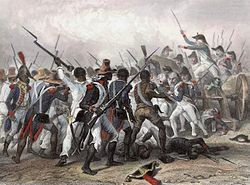 |
- Santo Domingo Slave Revolt (1521)
- San Miguel de Gualdape (1526)
- Bayano Wars (1548)
- Gaspar Yanga's Revolt (c. 1570) near the Mexican city of Veracruz; the group escaped to the highlands and built a free colony
- Revolt in Gloucester County, Virginia (1663)
- New York Slave Revolt of 1712
- Samba Rebellion (1731)
- Stono Rebellion (1739)
- New York Conspiracy of 1741 (alleged)
- During the American Revolutionary War, slaves reacted to Dunmore's Proclamation and the Philipsburg Proclamation, fleeing and sometimes taking up arms in the British military against their former masters (for example in the Ethiopian Regiment).
- 1791 Mina conspiracy
- Pointe Coupée conspiracy (1794)
- Gabriel's Rebellion (1800)
- Rebellions in a dozen North Carolina counties (May and June, 1802)
- Chatham Manor Rebellion (1805)
- Slaves in three North Carolina counties conspire to poison their owners, in some cases successfully. (1805)
- 1811 German Coast Uprising
- Aponte Conspiracy (1812)
- George Boxley Rebellion (1815)
- Denmark Vesey's conspiracy (1822)
- Nat Turner's slave rebellion (1831)
- Black Seminole Slave Rebellion (1835–1838)
- Amistad seizure (1839)
- Creole case (1841) (the most successful slave revolt in US history)
- 1842 Slave Revolt in the Cherokee Nation
- John Brown's raid on Harpers Ferry (1859) (failed attempt to organize a slave rebellion)
Africa
In 1808 and 1825, there were slave rebellions in the Cape Colony, newly acquired by the British. Although the slave trade was officially abolished in the British Empire by the Slave Trade Act of 1807, and slavery itself a generation later with the Slavery Abolition Act 1833, it took until 1850 to be halted in the territories which were to become South Africa.
Slave ship revolts
There are 485 recorded instances of slaves revolting on board slave ships. A few of these ships endured more than one uprising during their career.
Most accounts of revolts aboard slave ships are given by Europeans. There are few examples of accounts by slaves themselves. William Snelgrave reported that the slaves who revolted on the British ship Henry in 1721 claimed that those who had captured them were "Rogues to buy them" and that they were bent on regaining their liberty. Another example that Richardson gives is that of James Towne who gives the account of slaves stating that Europeans did not have the right to enslave and take them away from their homeland and "wives and children."
Richardson compares several factors that contributed to slave revolts on board ships: conditions on the ships, geographical location, and proximity to the shore. He suggests that revolts were more likely to occur when a ship was still in sight of the shore. The threat of attack from the shore by other Africans was also a concern. If the ship was hit by disease and a large portion of the crew had been killed, the chances of insurrection were higher. Where the slaves were captured also had an effect on the number of insurrections. In many places, such as the Bight of Benin and the Bight of Biafra, the percentage of revolts and the percentage of the slave trade match up. Yet ships taking slaves from Senegambia experienced 22 percent of shipboard revolts while only contributing to four and a half percent of the slave trade. Slaves coming from West Central Africa accounted for 44 percent of the trade while only experiencing 11 percent of total revolts.
Lorenzo J. Greene gives many accounts of slave revolts on ships coming out of New England. These ships belonged to Puritans who controlled much of the slave trade in New England. Most revolts on board ships were unsuccessful. The crews of these ships, while outnumbered, were disciplined, well fed, and armed with muskets, swords, and sometimes cannons, and they were always on guard for resistance. The slaves on the other hand were the opposite, armed only with bits of wood and the chains that bound them.
However, some captives were able to take over the ships that were their prisons and regain their freedom. On October 5, 1764 the New Hampshire ship Adventure captained by John Millar was successfully taken by its cargo. The slaves on board revolted while the ship was anchored off the coast and all but two of the crew, including Captain Millar, had succumbed to disease. Another successful slave revolt occurred six days after the ship Little George had left the Guinea coast. The ship carried ninety-six slaves, thirty-five of which were male. The slaves attacked in the early hours of the morning, easily overpowering the two men on guard. The slaves were able to load one of the cannons on board and fire it at the crew. After taking control of the ship they sailed it up the Sierra Leone River and escaped. After having defended themselves with muskets for several days below decks the crew lowered a small boat into the river to escape. After nine days of living on raw rice they were rescued.
There is one factor that is not addressed by either Richardson or Greene. That is of enslaved sailors on slave ships. While Mariana P. Candido does not write explicitly on revolts, she does discuss there being enslaved Africans working on the ships that transported other Africans into slavery. These men, 230 in all, were used onboard slave ships for their ability to communicate with the slaves being brought on board and to translate between Captain and slaver. Enslaved sailors were able to alleviate some of the fears that newly boarded slaves had, such as fear of being eaten. This was a double-edged sword. The enslaved sailors sometimes joined other slaves in the revolts against the captain they served. In 1812 enslaved sailors joined a revolt on board the Portuguese ship Feliz Eugenia just off the coast of Benguela. The revolt took place below decks. The sailors, along with many of the children who were on board, were able to escape using small boats.



